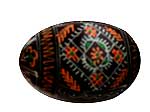
|
Eastern
Eggs When most people think of Easter, the first image that comes to mind is a fancy-painted egg. Few, however, know about the rich Ukrainian history and symbolism of the eggs. The
art of pysanky, or Ukrainian Easter eggs, is so ancient that no
one truly knows its origins. At least 2000 years ago, people who
lived in the area of Ukraine worshipped the sun. These pagan people
saw parallels between the yellow yolk of the egg and the sun, and
the white of the egg and the moon. The egg was believed to have
magical power and often was used in sun worship ceremonies. The egg is a symbol of birth — it is the origin of life. The egg, which holds within itself the embryo of life, was also considered to be a symbol of fertility in nature and the everlasting continuity of life. It is the power of the egg to create a new life that made it so mysterious to pagan believers. When Ukrainians accepted Christianity in 988 A.D., the meaning of the egg was expanded to include the representation of man’s rebirth. The egg was now likened to the tomb from which Christ arose. It was now used to commemorate the Resurrection. Many legends about the origin of Easter eggs exist. One legend is that when Christ was dying on the cross, blood flowing from his wounds fell on the ground, and wherever a drop fell, a red Easter egg was created. The Virgin Mary was standing beneath his cross praying and crying. Those red Easter eggs on which her tears landed, in turn, became elaborately decorated Easter eggs. Mary gathered all the eggs into a handkerchief and went to Pontius Pilate to ask for permission to bury her son. On her way there, she gave an Easter egg to each child she met, along with the admonition to live in peace. Arriving at Pilate’s palace, Mary fainted, and the Easter eggs from her handkerchief rolled all over the world. From that day on, people in Ukraine decorate eggs at Easter time and give them to each other as an expression of love and peace. Types of eggs There are four main types of Easter eggs: krashanky, krapanky, dryapanky and of course, pysanky. Krashanka basically means “the painted one,” as derived from the word kraska, which means “paint,” or “color.” It is simply a hard-boiled egg dyed a solid color with no design. It is the most primitive type of Easter egg. Krapanka is a simple Easter egg with multi-colored dots of varying sizes. Krapka means “dot” in Ukrainian. Dryapanka is a solid-colored Easter egg with a scratched design. Dryapaty means “to scratch.” Scratching designs with a sharp pointed metal instrument onto the egg is one of the oldest methods of decoration. Designs featuring plants are most common in this type. They have a delicate, lace-like appearance. The word pysanka derives from Ukrainian pysaty, which means “to write.” Pysanka is a multi-colored egg with complex designs of symbolic nature. The designs are drawn on the egg with a fine pointed stylus dipped in melted wax. The pysanka, which is brought to church Easter morning to be blessed, is never boiled. Boiling it would kill the life in itthus destroying the very symbolism it carries. Once consecrated, the pysanka becomes a true Easter egg, and it is believed to have the power of bringing God’s grace into a household. It is given to friends as a token of respect and love, accompanied with sincere good wishes for health and happiness during the holiday season. The Symbolism The Ukrainian Easter egg is wrapped in symbolism. It is not only the egg itself that stands for something but also the colors it is painted with, and the designs drawn on it. Each
color, and even different shades of a color has its own meaning.
The individual motifs drawn on the eggs can be classified into three categories: geometric, plant and animal. Some of them date back to the pagan times and have taken on Christian meanings with the advent of this religion. Others, of course, have been added to convey the Christian concepts. Geometric motifs are the oldest and most general form of decoration. The symbols of the sun are the most ancient and significant motifs. The sun is represented by a circle. Sometimes straight or curved spokes are painted around the circle to represent the sun’s rays. The sun symbolizes growth, good fortune and happiness. Swastika is another popular motif, also known as the broken cross, windmill, scythe, and lily. It symbolizes happiness. During the pagan times, swastika resembled a tripod, which represented a trinity such as birth, life and death. The geometric, eight-pointed star, also known as a rose, is very popular in egg decorating. It usually stands alone without carrying any other motifs. It symbolizes God’s love toward men. Ribbon or belt encircling the egg symbolizes eternity. It is called the “endless line” since it goes around the egg, having no beginning or end. The cross appears in many forms, and is one of the most popular motifs. To no surprise, it represents the suffering, death and resurrection of Jesus Christ. Small and large dots are sometimes scattered over the field of a design suggesting stars. They symbolize Virgin Mary’s tears as she wept for Jesus. During pagan times, the triangle symbolized the air, fire and water. After Christianity was introduced, it took on a new meaning, now representing the Holy Trinity. Sieves, nets, and small baskets are also encountered in egg decorating. The sieve and the net are a symbol of dividing the good from evil. The basket suggests knowledge. Rakes, whether drawn one at a time or in bunches, represent good husbandry and prosperity. Spirals represent immortality, while ladders suggest searching. The Hutzul people of the western Ukraine also like using the church motif. A church is represented by the combination of the cross and triangles. Plant motifs are not as ancient as the geometric. Either a whole plant or parts of it are drawn, symbolizing the rebirth of nature and life. The motif is usually not meant to represent the plan in its natural detail. Different types of flowers symbolize love and charity. Among leaves, periwinkle also symbolizes love, while oak leaf represents strength. A more stylized, geometric rose symbolizes beauty and wisdom. Among berries, grapes, cherries, apples, and plums are used to symbolize health and wisdom. Wheat represents wishes for a bountiful harvest. Pine trees symbolize health and stamina, whereas broad-leafed trees stand for rebirth of nature and life. Animal motifs are probably nearly as old as the geometric ones. In fact, they are not used independently but are included with the latter. Either entire body of an animal, or its parts may be drawn. Each of the animal drawings is rich in symbolism, just like the other two types of ornamentation. For example, chicken, duck, or goose feet denote guidance to the young, whereas horns suggest strength and leadership. Butterflies are a symbol of Resurrection. Spiders symbolize patience. Birds, such as storks, hens, roosters and sparrows represent joy, fulfillment of wishes, and fertility. Fish are a symbol of Christianity, as well as sacrifice. Deer and horses symbolize wealth and prosperity and stags and rams represent leadership and strength. Though Easter is rapidly approaching there is still time to sit down and enjoy the ancient tradition of Ukrainian egg painting. Wanda
Muriy |
|
|
TCU Daily Skiff © 2002 |
||


